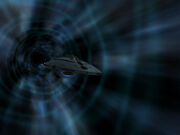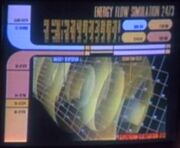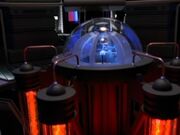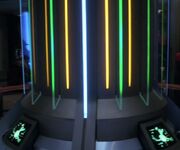AT: "xx"

Voyager navigates the slipstream

A computer simulation of a slipstream
The quantum slipstream drive was an advanced form of propulsion technology first encountered by the USS Voyager in the Delta Quadrant, which had the capability of exceeding a starship's maximum warp factor by an unprecedented degree. Similar in principle to the transwarp technology utilized by the Borg, it was originally developed by a Delta Quadrant race designated by the Borg as "Species 116."
Technical data
Quantum slipstream drive operated by routing energy through the vessel's main deflector, which then focused a quantum field, allowing the vessel to penetrate the quantum barrier. In order to maintain the slipstream, the phase variance of the quantum field had to be constantly adjusted, or the slipstream would collapse, violently throwing the ship back into normal space.
History

The Dauntless's quantum slipstream drive
The Voyager crew first encountered slipstream technology in 2374, when they discovered the USS Dauntless, a vessel ostensibly sent by Starfleet to transport them back to the Alpha Quadrant. It was subsequently discovered, however, that the vessel was an elaborate ruse by an alien named Arturis, who was seeking revenge on Captain Janeway for what he saw as her complicity in the assimilation of his species by the Borg. Planning to use the Dauntless to transport the Voyager crew back to his Borg-conquered homeworld for assimilation, Arturis settled for Janeway and Seven of Nine when his plot was discovered. Arturis was pursued in the slipstream by Voyager, which had been outfitted with the same technology. Lieutenant Commander Tuvok managed to breach the Dauntless's shields with a photon torpedo, allowing them to rescue Janeway and Seven. Commander Chakotay subsequently ordered their slipstream altered in order to avoid Borg space, leaving Arturis to be assimilated. Voyager remained in the slipstream for an hour before it collapsed, traversing three hundred light years, although their diagnostics concluded that they could not risk using the technology again. (VOY: "Hope and Fear")

Voyager's slipstream drive
The next year, the Voyager crew constructed their own quantum slipstream drive using benamite crystals, overcoming some difficulties in their first attempt. Despite promising potential results, Tom Paris discovered a phase variance in the slipstream threshold, threatening to overload the drive's quantum matrix and destroy the ship. Harry Kim realized that the smaller size of a piloted shuttle leading Voyager could allow early phase variance detection of the complex, dynamic slipstream threshold for the larger ship. These advance data and corrections would help Voyager safely navigate the quantum slipstream. During the test flight, with Chakotay piloting the Delta Flyer, Kim sent wrong correction values to Voyager, causing the slipstream to unexpectedly collapse ten light years near the Alpha Quadrant. Voyager crashed on an class L planet in the Takara sector, killing all hands – however, ahead of Voyager in the stable Delta Flyer slipstream, Kim and Chakotay survived the disastrous test and returned to Earth, filled with guilt. Fifteen years later, the pair acquired a stolen Borg temporal transmitter and recovered The Doctor's program from Voyager's debris, and attempted to change history by allowing Voyager to stay in the slipstream. With The Doctor's expertise of Seven of Nine's physiology, Kim and Chakotay used the Borg technology to transmit a time index and new phase corrections back in time to Seven of Nine's interplexing beacon. The initial corrections did not work – with no chance to correct their mistake, The Doctor convinced Kim to give up on the Alpha Quadrant and at least avert the disaster by transmitting information which would end the flight rather than prolong it. As Seven implemented these new corrections, the slipstream dispersed and returned Voyager safely to normal space – eliminating approximately ten years from their journey to the Alpha Quadrant. (VOY: "Timeless")
See also
Appendices
Appearances
- VOY:
- "Hope and Fear"
- "Timeless"
- "Think Tank"
Background Information
The quantum slipstream core prop is made up of a novelty plasma globe and "bubble tubes", available from most joke/gadget shops. (Delta Quadrant: The Unofficial Guide to Voyager, p. 248)
The drive was discussed in detail in the "Briefing: Propulsion Systems" article in Star Trek: The Magazine Volume 2, Issue 4.
The slipstream drive became a more prominently featured method of FTL propulsion in Gene Roddenberry's Andromeda sci-fi series that premiered in 2000.
Apocrypha
The Star Trek: Destiny trilogy introduced the Vesta-class starships, a testbed for a Federation quantum slipstream drive, along with numerous other technologies.
In A Singular Destiny Starfleet began to install quantum slipstream drives on its vessels in 2381. Due to the nature of the technology, not all ships were compatible with the upgrade. An upgraded version of the technology proved to be successful, and in the novel Full Circle Starfleet mounted an expedition to the Delta Quadrant by outfitting Voyager and several other starships with a fully functional version of the drive.
In the Star Trek: Typhon Pact novel Zero Sum Game, the Breen sent an operative to Utopia Planitia Fleet Yards to capture data pertaining to the Quantum slipstream drive. The Breen were then contracted to build the first Typhon Pact prototype slipstream vessel. The lead researcher of the project, Thot Keer, intentionally withheld information from the other members relating to the drive's development in order to promote the Breen to a level of Pact authority of equal standing to the Romulans. Shortly before the initial trials, the prototype, its designer, and all information relating to the project were destroyed.
In Star Trek Online, players are able to use slipstream drives for brief periods after reaching Vice Admiral rank in order to travel faster between star systems.
External link
- Template:NCwiki
